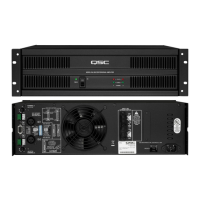FEATURES & SETUP- CLIP LIMITER & DIP SWITCH SETTINGS
CAUTION: Clip limiting reduces extreme overdrive peaks, allowing a higher average signal level without audible
distortion. However, increasing the gain with the clip limiter engaged, until clipping is again audible, can double
the average output power. Be careful not to exceed the power rating of your speakers.
How to use it:
When to use it:
When the audio input signal drives the amplifier’s output circuit
beyond its power capability, the amplifier clips and flattens the
peaks of the waveform. This flattening is what we hear as
distortion during the clipping “event”.
Clipping for short periods can be harmless. Clipping for extended
periods can easily damage high frequency drivers (tweeters,
horns) . Low frequency drivers can tolerate all but severe
clipping; severe clipping can damage any of the systems power
components and should be avoided entirely.
The clip limiter detects clipping (even short events) and quickly
reduces the gain to minimize the amount of overdrive. To
preserve as much of the program dynamics as possible, the ISA
amplifier has limiters which respond only to amplifier clipping.
There is a switchable clip limiter provided for each channel.
CLIP LIMITER selection switches, all models.
Note! In BRIDGE mode, channel 2’s CLIP LIMITER must
be placed in the OFF position for proper operation.
In BRIDGE mode, Channel 2’s clip limiter must be set to the off position to avoid any interaction.
We recommend using the clip limiters in all applications.
When driving full-range speakers, clip limiting reduces high frequency distortion caused
by bass overload. It also protects high frequency drivers from excess overdrive and harsh
clipping harmonics.
When using 70V or 100V transformers, clip limiting prevents excessive overdrive which
could saturate the coupling transformers. See “Low Frequency Filtering For 70-100V
Systems”, page 28.
If operating in stereo or parallel mode,
the two limiters are completely independent
of one another.
1- Set each channel’s clip limiter selection switch on or off as desired.
Switch #1 sets channel 1’s limiter. Switch #10 sets channel 2’s limiter.
If operating in bridge mode,
channel 1’s clip limiter switch is used to engage or disable
the clip limiter; channel 2’s clip limiter must be switched off.
1- Set channel 2’s clip limiter switch to the off position. This is switch #10.
2- Set channel 1’s clip limiter switch on or off as desired. This is switch #1.
15

